Cholesterol's Effects on Heart Disease: Indigenous Australian Health
VerifiedAdded on 2022/10/19
|10
|879
|24
Report
AI Summary
This report, prepared for a presentation, investigates the impact of cholesterol on the health of Aboriginal and Torres Strait Islander peoples. It defines cholesterol, differentiates between HDL and LDL, and outlines the causes and prevalence of high cholesterol within this population, citing statistics from the Australian Bureau of Statistics. The report details the association between high cholesterol and heart disease, including the pathophysiology of atherosclerosis, and the increased risk of coronary heart disease and stroke. Recommendations include promoting healthy eating habits, regular cardiovascular risk assessments, and lifestyle changes to reduce cholesterol levels. The report also identifies nursing considerations, relating these to the Registered Nurse Scope of Practice, and provides references in APA format, supporting the presented information with published literature.
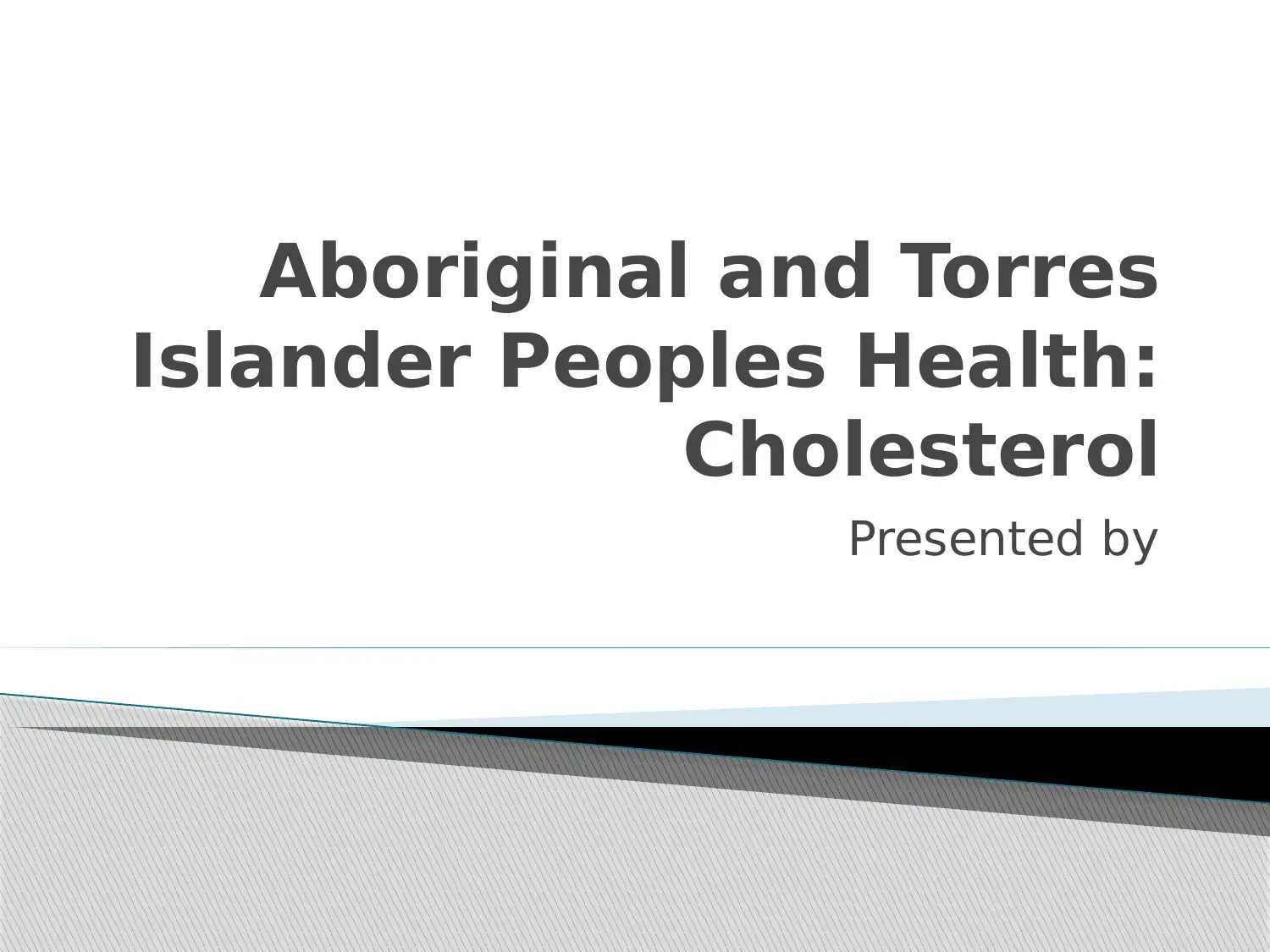
Aboriginal and Torres
Islander Peoples Health:
Cholesterol
Presented by
Islander Peoples Health:
Cholesterol
Presented by
Paraphrase This Document
Need a fresh take? Get an instant paraphrase of this document with our AI Paraphraser
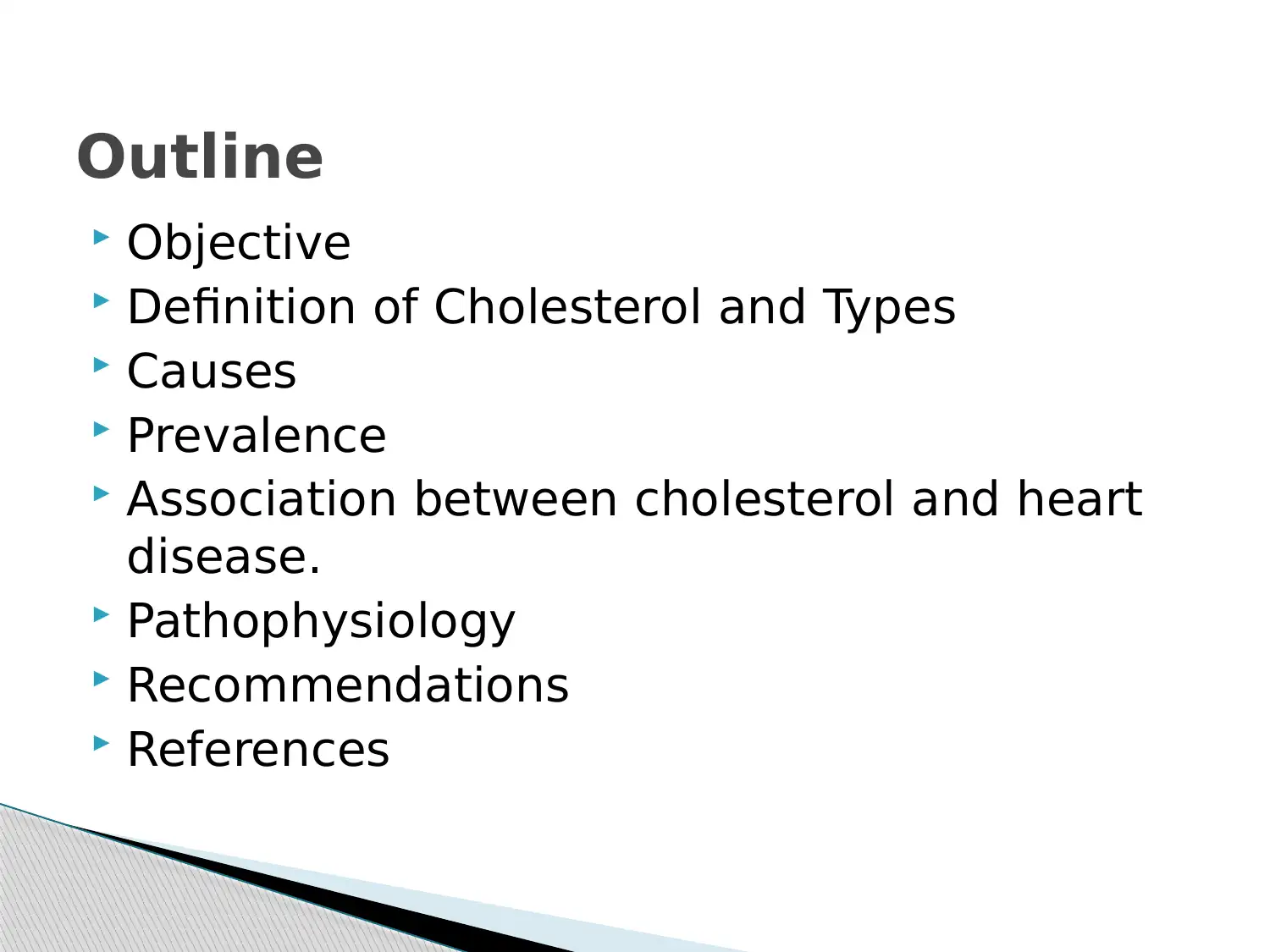
Objective
Definition of Cholesterol and Types
Causes
Prevalence
Association between cholesterol and heart
disease.
Pathophysiology
Recommendations
References
Outline
Definition of Cholesterol and Types
Causes
Prevalence
Association between cholesterol and heart
disease.
Pathophysiology
Recommendations
References
Outline
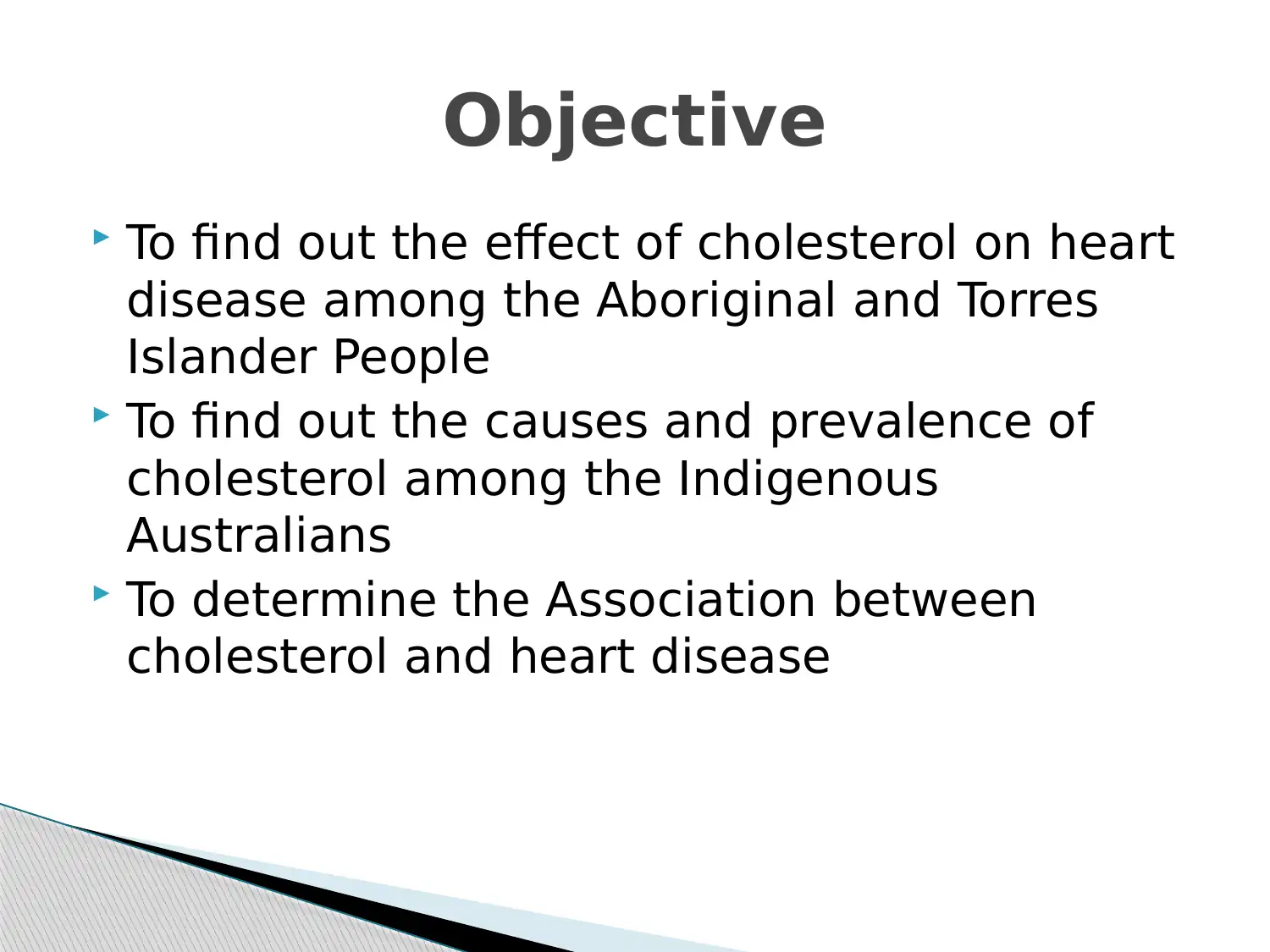
To find out the effect of cholesterol on heart
disease among the Aboriginal and Torres
Islander People
To find out the causes and prevalence of
cholesterol among the Indigenous
Australians
To determine the Association between
cholesterol and heart disease
Objective
disease among the Aboriginal and Torres
Islander People
To find out the causes and prevalence of
cholesterol among the Indigenous
Australians
To determine the Association between
cholesterol and heart disease
Objective
⊘ This is a preview!⊘
Do you want full access?
Subscribe today to unlock all pages.

Trusted by 1+ million students worldwide
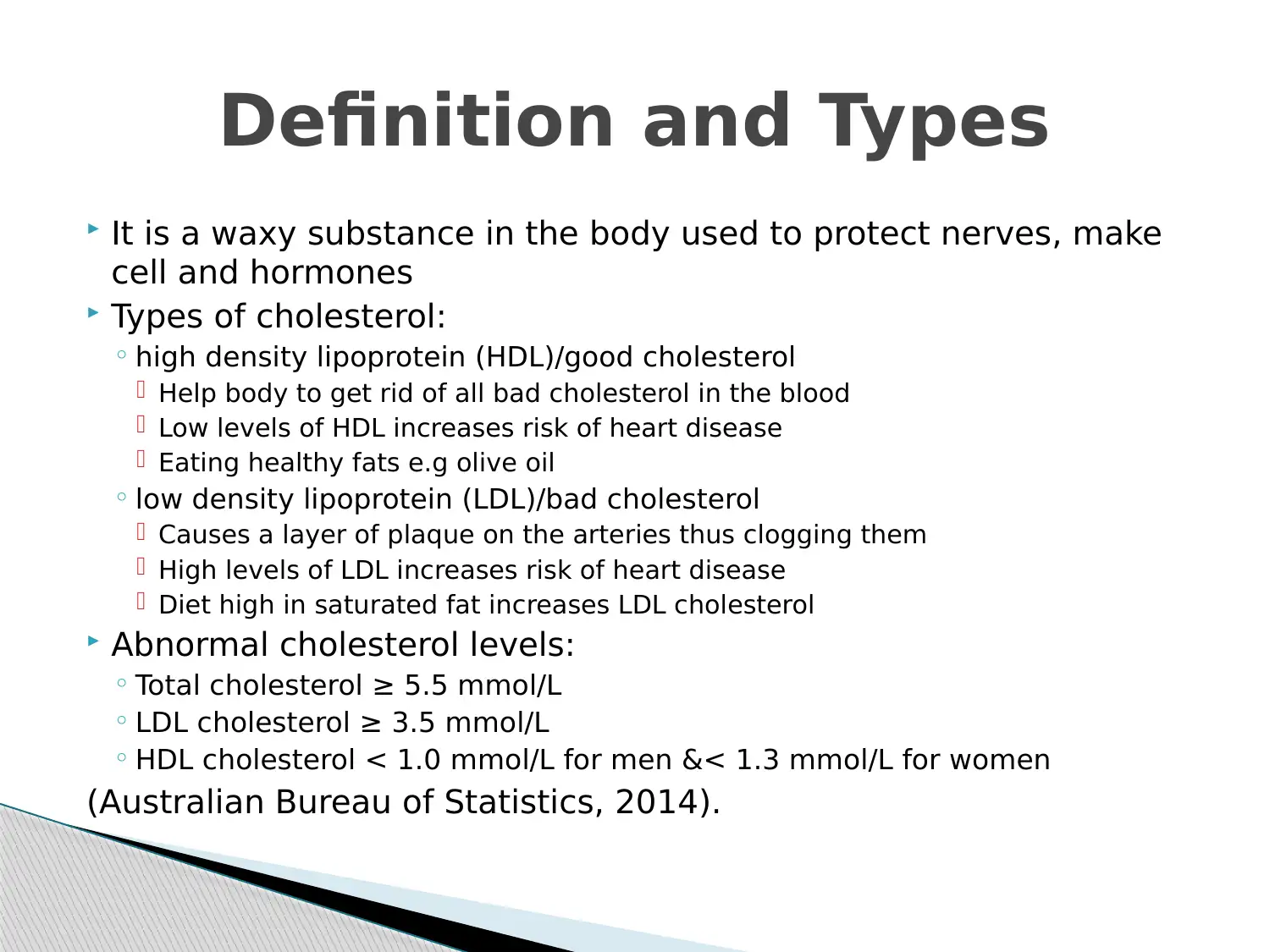
It is a waxy substance in the body used to protect nerves, make
cell and hormones
Types of cholesterol:
◦ high density lipoprotein (HDL)/good cholesterol
Help body to get rid of all bad cholesterol in the blood
Low levels of HDL increases risk of heart disease
Eating healthy fats e.g olive oil
◦ low density lipoprotein (LDL)/bad cholesterol
Causes a layer of plaque on the arteries thus clogging them
High levels of LDL increases risk of heart disease
Diet high in saturated fat increases LDL cholesterol
Abnormal cholesterol levels:
◦ Total cholesterol ≥ 5.5 mmol/L
◦ LDL cholesterol ≥ 3.5 mmol/L
◦ HDL cholesterol < 1.0 mmol/L for men &< 1.3 mmol/L for women
(Australian Bureau of Statistics, 2014).
Definition and Types
cell and hormones
Types of cholesterol:
◦ high density lipoprotein (HDL)/good cholesterol
Help body to get rid of all bad cholesterol in the blood
Low levels of HDL increases risk of heart disease
Eating healthy fats e.g olive oil
◦ low density lipoprotein (LDL)/bad cholesterol
Causes a layer of plaque on the arteries thus clogging them
High levels of LDL increases risk of heart disease
Diet high in saturated fat increases LDL cholesterol
Abnormal cholesterol levels:
◦ Total cholesterol ≥ 5.5 mmol/L
◦ LDL cholesterol ≥ 3.5 mmol/L
◦ HDL cholesterol < 1.0 mmol/L for men &< 1.3 mmol/L for women
(Australian Bureau of Statistics, 2014).
Definition and Types
Paraphrase This Document
Need a fresh take? Get an instant paraphrase of this document with our AI Paraphraser
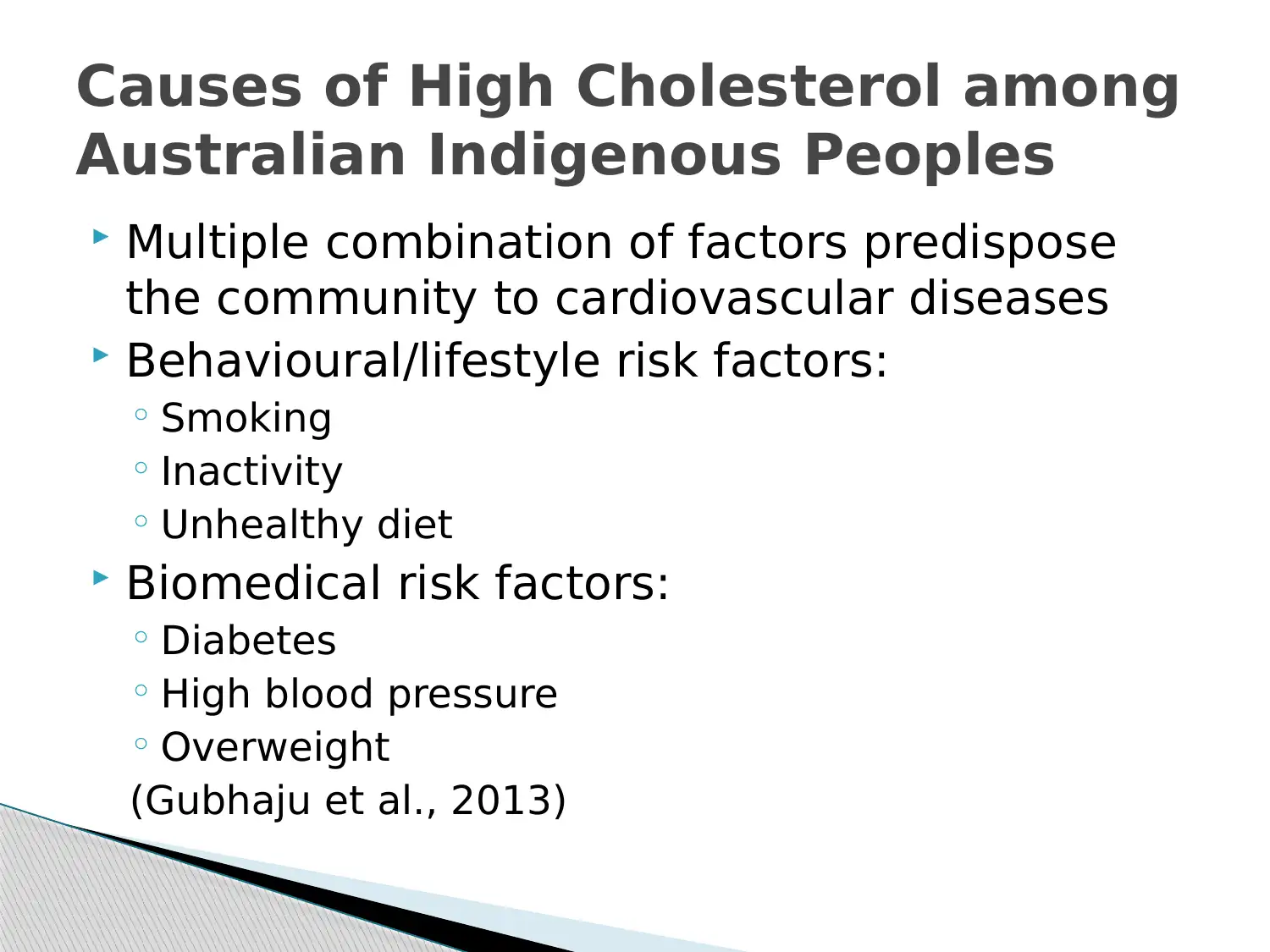
Multiple combination of factors predispose
the community to cardiovascular diseases
Behavioural/lifestyle risk factors:
◦ Smoking
◦ Inactivity
◦ Unhealthy diet
Biomedical risk factors:
◦ Diabetes
◦ High blood pressure
◦ Overweight
(Gubhaju et al., 2013)
Causes of High Cholesterol among
Australian Indigenous Peoples
the community to cardiovascular diseases
Behavioural/lifestyle risk factors:
◦ Smoking
◦ Inactivity
◦ Unhealthy diet
Biomedical risk factors:
◦ Diabetes
◦ High blood pressure
◦ Overweight
(Gubhaju et al., 2013)
Causes of High Cholesterol among
Australian Indigenous Peoples
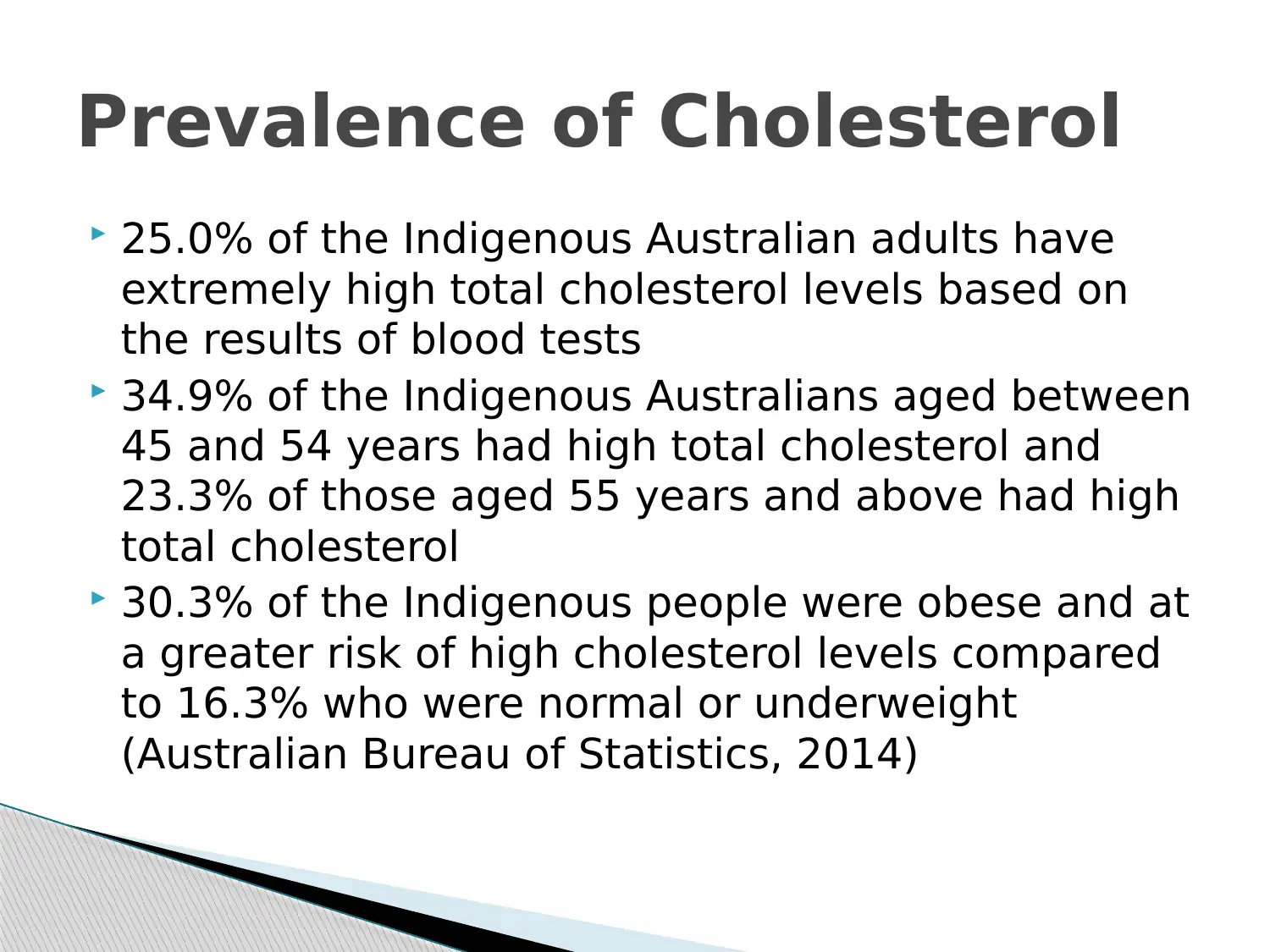
25.0% of the Indigenous Australian adults have
extremely high total cholesterol levels based on
the results of blood tests
34.9% of the Indigenous Australians aged between
45 and 54 years had high total cholesterol and
23.3% of those aged 55 years and above had high
total cholesterol
30.3% of the Indigenous people were obese and at
a greater risk of high cholesterol levels compared
to 16.3% who were normal or underweight
(Australian Bureau of Statistics, 2014)
Prevalence of Cholesterol
extremely high total cholesterol levels based on
the results of blood tests
34.9% of the Indigenous Australians aged between
45 and 54 years had high total cholesterol and
23.3% of those aged 55 years and above had high
total cholesterol
30.3% of the Indigenous people were obese and at
a greater risk of high cholesterol levels compared
to 16.3% who were normal or underweight
(Australian Bureau of Statistics, 2014)
Prevalence of Cholesterol
⊘ This is a preview!⊘
Do you want full access?
Subscribe today to unlock all pages.

Trusted by 1+ million students worldwide
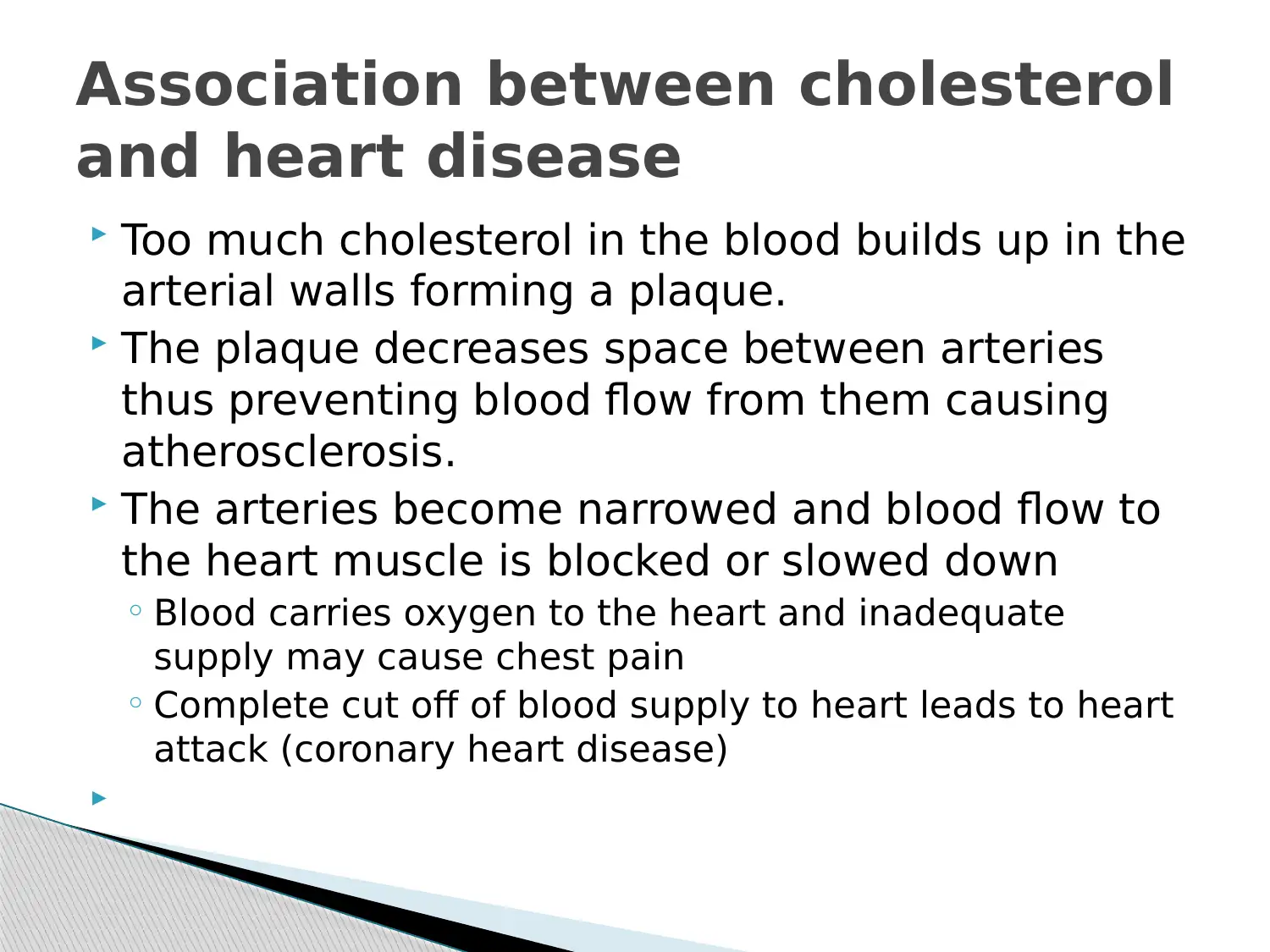
Too much cholesterol in the blood builds up in the
arterial walls forming a plaque.
The plaque decreases space between arteries
thus preventing blood flow from them causing
atherosclerosis.
The arteries become narrowed and blood flow to
the heart muscle is blocked or slowed down
◦ Blood carries oxygen to the heart and inadequate
supply may cause chest pain
◦ Complete cut off of blood supply to heart leads to heart
attack (coronary heart disease)
Association between cholesterol
and heart disease
arterial walls forming a plaque.
The plaque decreases space between arteries
thus preventing blood flow from them causing
atherosclerosis.
The arteries become narrowed and blood flow to
the heart muscle is blocked or slowed down
◦ Blood carries oxygen to the heart and inadequate
supply may cause chest pain
◦ Complete cut off of blood supply to heart leads to heart
attack (coronary heart disease)
Association between cholesterol
and heart disease
Paraphrase This Document
Need a fresh take? Get an instant paraphrase of this document with our AI Paraphraser
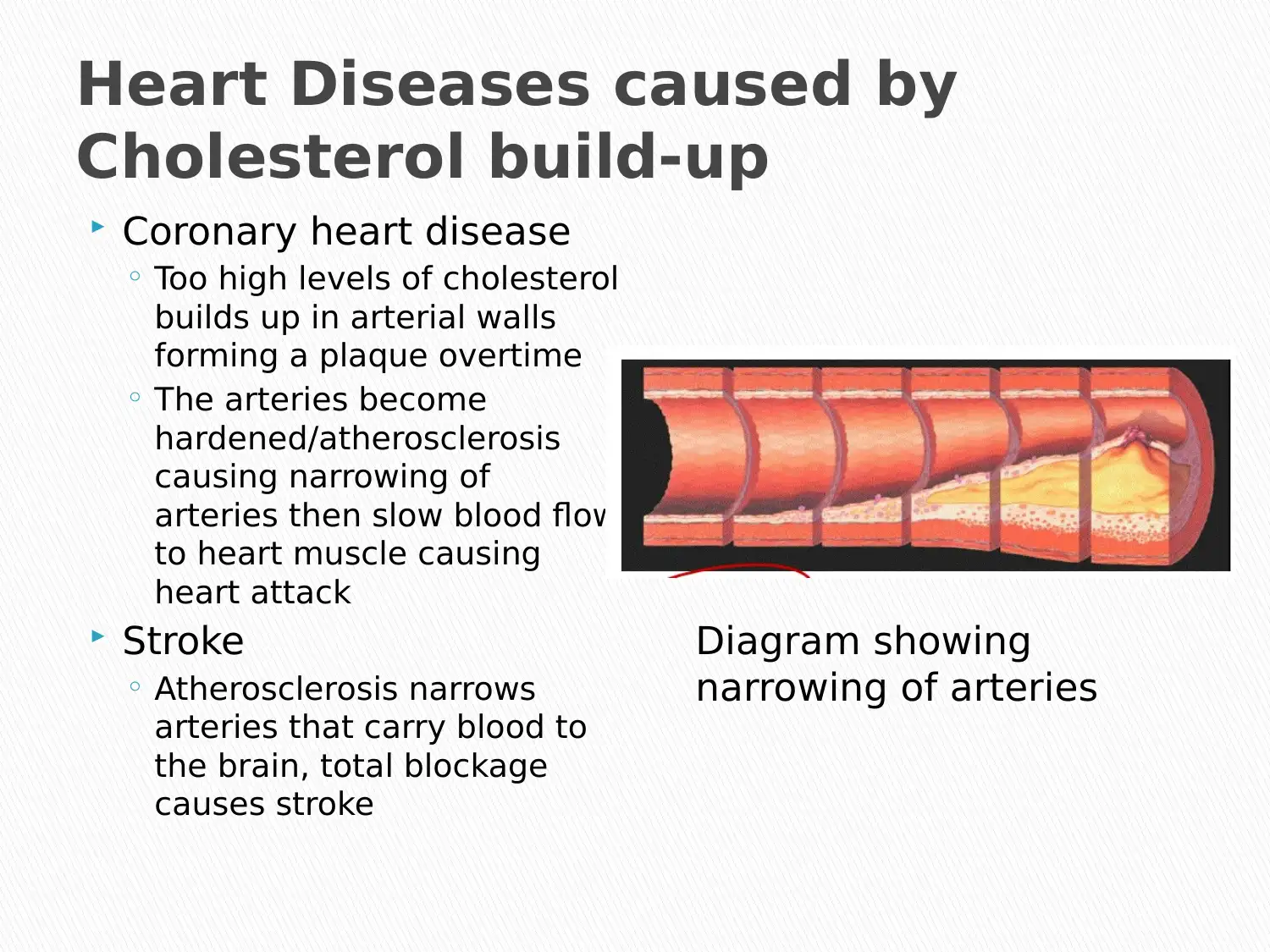
Heart Diseases caused by
Cholesterol build-up
Diagram showing
narrowing of arteries
Coronary heart disease
◦ Too high levels of cholesterol
builds up in arterial walls
forming a plaque overtime
◦ The arteries become
hardened/atherosclerosis
causing narrowing of
arteries then slow blood flow
to heart muscle causing
heart attack
Stroke
◦ Atherosclerosis narrows
arteries that carry blood to
the brain, total blockage
causes stroke
Cholesterol build-up
Diagram showing
narrowing of arteries
Coronary heart disease
◦ Too high levels of cholesterol
builds up in arterial walls
forming a plaque overtime
◦ The arteries become
hardened/atherosclerosis
causing narrowing of
arteries then slow blood flow
to heart muscle causing
heart attack
Stroke
◦ Atherosclerosis narrows
arteries that carry blood to
the brain, total blockage
causes stroke
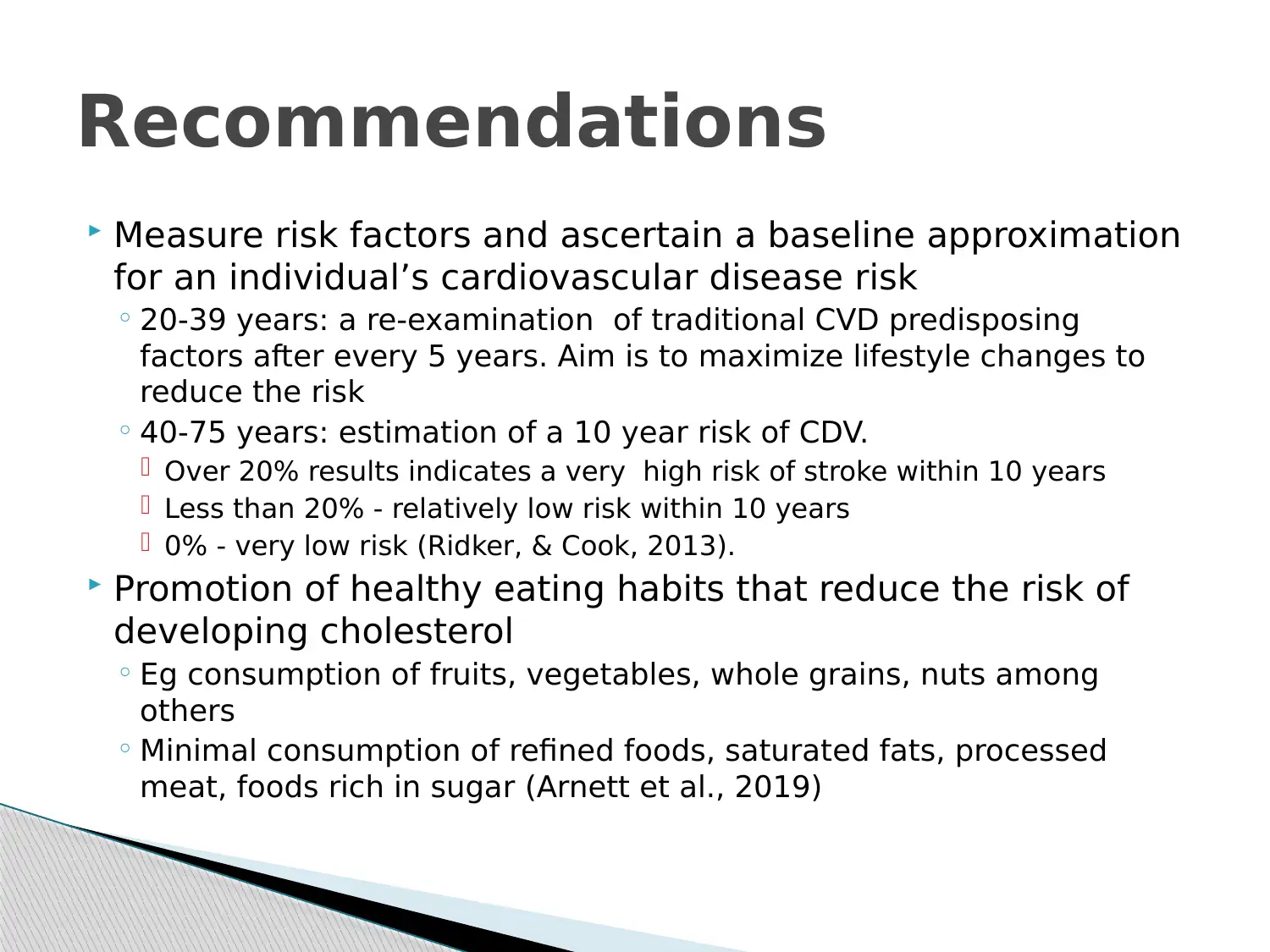
Measure risk factors and ascertain a baseline approximation
for an individual’s cardiovascular disease risk
◦ 20-39 years: a re-examination of traditional CVD predisposing
factors after every 5 years. Aim is to maximize lifestyle changes to
reduce the risk
◦ 40-75 years: estimation of a 10 year risk of CDV.
Over 20% results indicates a very high risk of stroke within 10 years
Less than 20% - relatively low risk within 10 years
0% - very low risk (Ridker, & Cook, 2013).
Promotion of healthy eating habits that reduce the risk of
developing cholesterol
◦ Eg consumption of fruits, vegetables, whole grains, nuts among
others
◦ Minimal consumption of refined foods, saturated fats, processed
meat, foods rich in sugar (Arnett et al., 2019)
Recommendations
for an individual’s cardiovascular disease risk
◦ 20-39 years: a re-examination of traditional CVD predisposing
factors after every 5 years. Aim is to maximize lifestyle changes to
reduce the risk
◦ 40-75 years: estimation of a 10 year risk of CDV.
Over 20% results indicates a very high risk of stroke within 10 years
Less than 20% - relatively low risk within 10 years
0% - very low risk (Ridker, & Cook, 2013).
Promotion of healthy eating habits that reduce the risk of
developing cholesterol
◦ Eg consumption of fruits, vegetables, whole grains, nuts among
others
◦ Minimal consumption of refined foods, saturated fats, processed
meat, foods rich in sugar (Arnett et al., 2019)
Recommendations
⊘ This is a preview!⊘
Do you want full access?
Subscribe today to unlock all pages.

Trusted by 1+ million students worldwide
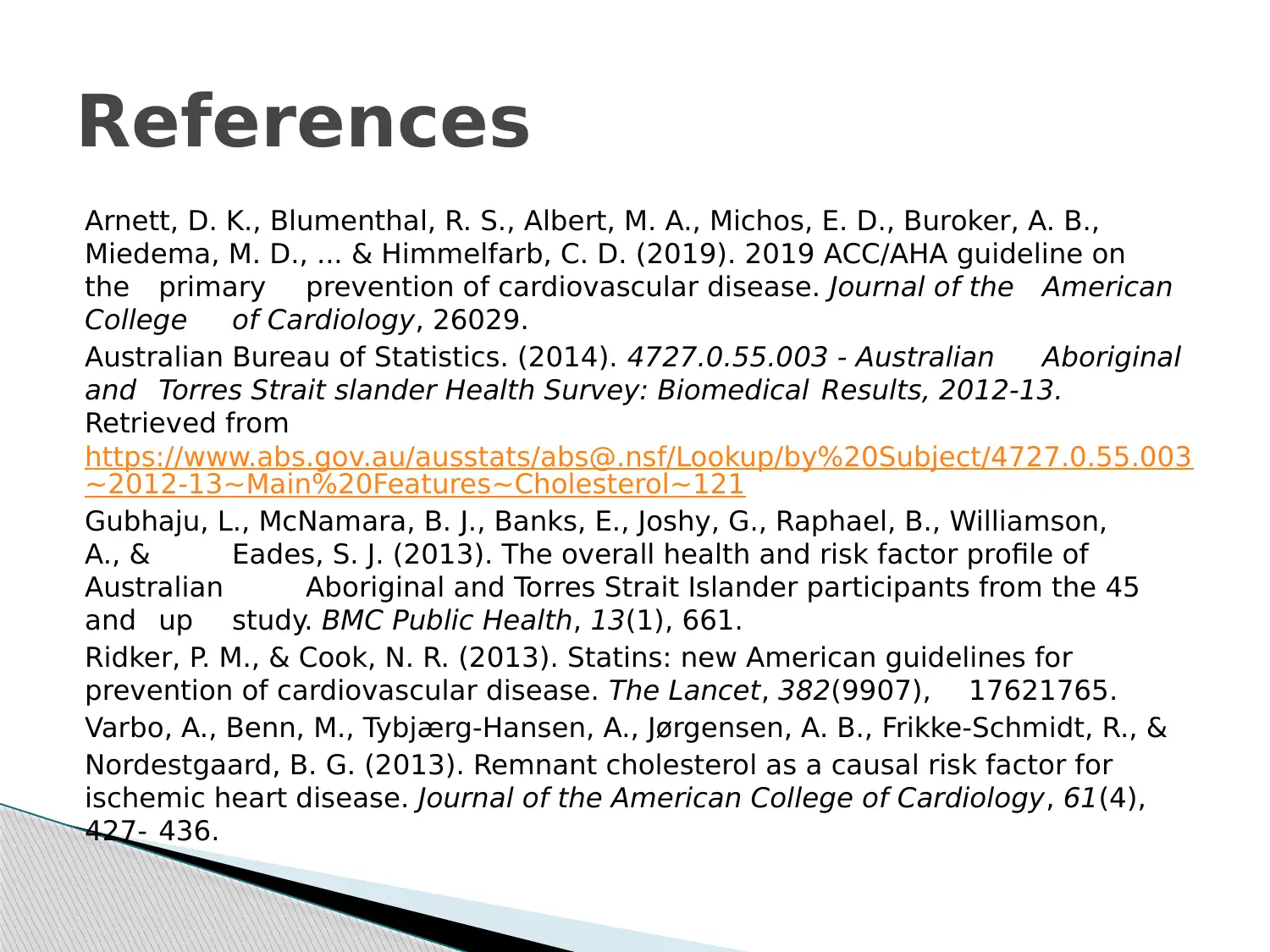
Arnett, D. K., Blumenthal, R. S., Albert, M. A., Michos, E. D., Buroker, A. B.,
Miedema, M. D., ... & Himmelfarb, C. D. (2019). 2019 ACC/AHA guideline on
the primary prevention of cardiovascular disease. Journal of the American
College of Cardiology, 26029.
Australian Bureau of Statistics. (2014). 4727.0.55.003 - Australian Aboriginal
and Torres Strait slander Health Survey: Biomedical Results, 2012-13.
Retrieved from
https://www.abs.gov.au/ausstats/abs@.nsf/Lookup/by%20Subject/4727.0.55.003
~2012-13~Main%20Features~Cholesterol~121
Gubhaju, L., McNamara, B. J., Banks, E., Joshy, G., Raphael, B., Williamson,
A., & Eades, S. J. (2013). The overall health and risk factor profile of
Australian Aboriginal and Torres Strait Islander participants from the 45
and up study. BMC Public Health, 13(1), 661.
Ridker, P. M., & Cook, N. R. (2013). Statins: new American guidelines for
prevention of cardiovascular disease. The Lancet, 382(9907), 17621765.
Varbo, A., Benn, M., Tybjærg-Hansen, A., Jørgensen, A. B., Frikke-Schmidt, R., &
Nordestgaard, B. G. (2013). Remnant cholesterol as a causal risk factor for
ischemic heart disease. Journal of the American College of Cardiology, 61(4),
427- 436.
References
Miedema, M. D., ... & Himmelfarb, C. D. (2019). 2019 ACC/AHA guideline on
the primary prevention of cardiovascular disease. Journal of the American
College of Cardiology, 26029.
Australian Bureau of Statistics. (2014). 4727.0.55.003 - Australian Aboriginal
and Torres Strait slander Health Survey: Biomedical Results, 2012-13.
Retrieved from
https://www.abs.gov.au/ausstats/abs@.nsf/Lookup/by%20Subject/4727.0.55.003
~2012-13~Main%20Features~Cholesterol~121
Gubhaju, L., McNamara, B. J., Banks, E., Joshy, G., Raphael, B., Williamson,
A., & Eades, S. J. (2013). The overall health and risk factor profile of
Australian Aboriginal and Torres Strait Islander participants from the 45
and up study. BMC Public Health, 13(1), 661.
Ridker, P. M., & Cook, N. R. (2013). Statins: new American guidelines for
prevention of cardiovascular disease. The Lancet, 382(9907), 17621765.
Varbo, A., Benn, M., Tybjærg-Hansen, A., Jørgensen, A. B., Frikke-Schmidt, R., &
Nordestgaard, B. G. (2013). Remnant cholesterol as a causal risk factor for
ischemic heart disease. Journal of the American College of Cardiology, 61(4),
427- 436.
References
1 out of 10
Related Documents
Your All-in-One AI-Powered Toolkit for Academic Success.
+13062052269
info@desklib.com
Available 24*7 on WhatsApp / Email
![[object Object]](/_next/static/media/star-bottom.7253800d.svg)
Unlock your academic potential
Copyright © 2020–2025 A2Z Services. All Rights Reserved. Developed and managed by ZUCOL.





